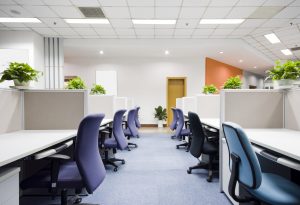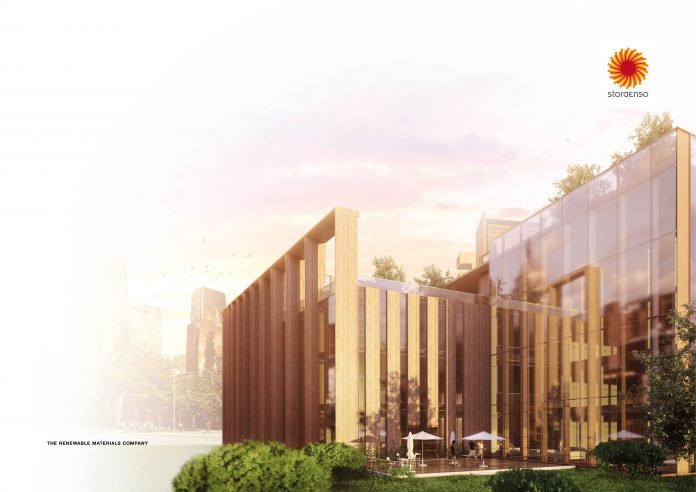As we slowly start to emerge from Covid-19 to a “new normal”, the way people view their working habits is changing. Rory Doak of Stora Enso argues there is now an important opportunity to rethink the office environment
Since the outbreak of the pandemic, the way we think and talk about the office has changed. New words have entered our vocabularies, such as employee experience; new trends have entered our planning, such as low-low density layouts; and new angles have become visible on old trends, such as sustainability.
Work is such an integral part of our lives that no doubt these changes will have repercussions for urban living and lifestyles more generally. For now, though, let’s limit our scope to the future of the office and ask how the why, where and what of office design may have been shifted by the pandemic, and examine these changes through a trifecta of characteristics: sustainability, size and “spread-ability”.
The new normal as the new why
At the time of writing, the pandemic is not done with us yet and it may be some time before the dust is finally settling and we really see what the “new normal” looks like (and how different it is to the old one).
However, there are some identifiable trends that look to be here to stay to at least some extent. One is working from home. Office-based workers have embraced the trend and there is a sense that there will be no going back to the strict presenteeism of before – there will be no putting the genie back in the bottle. In fact, according to YouGov, a slim majority of Brits (57%) want to continue to work from home after the pandemic, including a fifth who want to do so full-time.
This could have a number of knock-on effects on anything from house prices outside city centres to finally being able to get a seat on that morning rush-hour train. It seems inevitable that the shape of the British office is affected.
Where: Up and out?
At the height of the pandemic, some suggested that fear of commuting might weaken the gravitational pull of the city centre and see suburban office spaces flourish instead. Others insist that rumours of the city centre office’s demise have been greatly exaggerated, and that companies will either revert to prior working practices or find new uses for the space. We will look more closely at what those new uses might be in the next section but for now suffice to say that there is a potential source of demand brewing for more decentralised satellite office spaces.
On the alternate view, where the city centre office retains its importance, it is nevertheless difficult to see the same volume of completely new flagship developments added to the skyline. Instead, it is likely developers will look to be more resourceful with the space they already have or, where there is demand for some expansion, consider more innovative alternatives such as adding storeys to existing buildings.
These two possibilities are not mutually exclusive of course, and both begin to become quite interesting prospects when we consider them through our lenses of sustainability, size and spread-ability.
First, size. A less concentrated suburban workforce will naturally lend itself to smaller office developments. There won’t be a Canary Wharf in Watford anytime soon, whereas building up will result in spaces more similarly sized to what we are all used to.
As for spread-ability, it’s easy to imagine that more diffused office spaces and less concentration of the workforce in city centres might benefit resilience to future waves of this, or subsequent, pandemics. Sustainability is a more open question: shorter commutes may save energy but if they are shifted from public transport to private cars then the impact may be negative. It’s also likely that a network of small offices would take more materials and energy to serve its workforce than would a single well-designed premises.
These issues become clearer once we start looking at the what of the future office: its function, form and fabric.
What: Beautiful and biophilic
 As with anything, office design is subject to trends. The cubicle of the 1990s gave way to open-plan spaces that encouraged collaboration and communication but the density remained: it is simply more economic to have more desks crammed in a given space.
As with anything, office design is subject to trends. The cubicle of the 1990s gave way to open-plan spaces that encouraged collaboration and communication but the density remained: it is simply more economic to have more desks crammed in a given space.
However, in a post-pandemic world, will workers still be content to sit cheek-by-jowl with their colleagues? It may be that individuals demand more personal space to feel comfortable and reduce chances of infection. Fortunately, hybrid modes of working where employees mix days working from home with days in the office, make this possible by reducing the demands on desk space on any given day while accommodating the same number of employees overall over the course of the week.
So it may be that the pandemic leaves us with a trend for more spacious working environments. However, this is only one facet of the broader idea of employee experience. Could the viability of working from home mean companies have to work harder to tempt their people into suffering the commute? If so, what else might we see? Might employers be forced to create more attractive, even beautiful spaces for their workforces?
Here is where the pandemic-inspired trends intersect with one major trend already underway: sustainability and the trend towards biophilic design.
Biophilic design is the incorporation of nature and natural materials – simulated or real – into the built environment. It could range from a green wall to the use of wood as a building material. Biophilic design has been shown to aid performance and enhance wellbeing and may well be the ticket to creating spaces that attracts talent in tomorrow’s workforce.
One method of biophilic design in particular stands out: building with wood. Not only is (sustainably sourced) wood a low-carbon alternative to traditional building materials, it is proven to offer wellbeing and productivity benefits, and may even have some benefits for reducing the spread of covid versus metal.
What’s more, if we reintroduce the where factor of the future office, the case for wooden buildings is even more compelling. As a lighter alternative to traditional materials, engineered timber is ideal for adding storeys to existing buildings and as a highly modular building solution, it is ideal for quickly building mid-rise office blocks in suburban locales. In both of our where scenarios, then, wooden buildings are a sustainable enabler of potential new development trends.
Ultimately, though informative trends have emerged, the future of the office remains undecided. Much will depend on whether various stakeholders, including planners, developers and companies, make the effort to think anew or fall back into old habits. One thing is certain, though: the tragedy and chaos of the pandemic has created space to think differently about the office and created the possibility for a more beautiful, sustainable and human-friendly alternative.
Rory Doak
Business development manager UK & Ireland
Stora Enso
Tel: +46 1046 000 00
Twitter: @storaenso
LinkedIn: Stora Enso
YouTube: Stora Enso World
Instagram: @storaensoworld

















